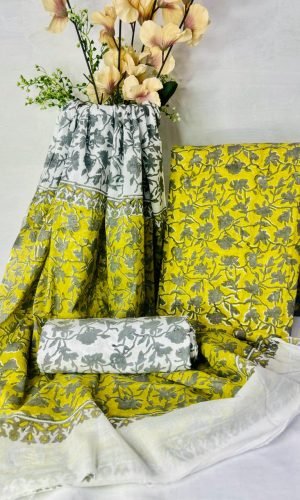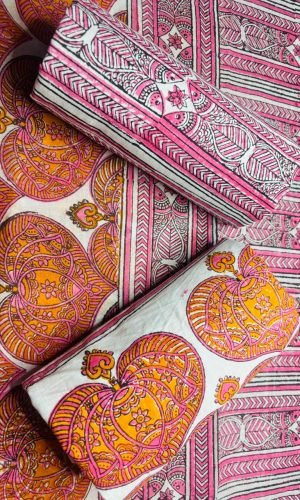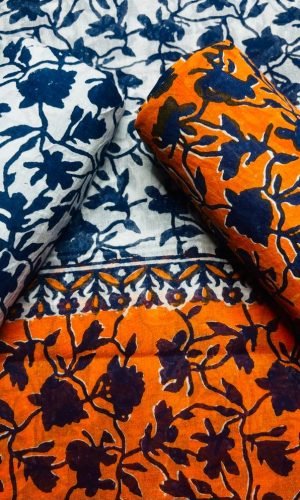The Origin of Block Printing in India: A Timeless Craft
Block printing, one of India’s oldest and most cherished art forms, is a vivid testament to the country’s rich cultural heritage. This ancient technique of creating intricate patterns on fabric holds a special place in Indian art history, blending creativity, craftsmanship, and tradition. Let’s explore the fascinating origin and evolution of block printing in India.
The Beginnings: Roots in Antiquity
Block printing has a history in India that dates back over 2,000 years. The earliest references to this craft can be traced to the Indus Valley Civilization (circa 2500–1500 BCE), where archaeologists unearthed fragments of dyed cotton cloth. Though evidence of block printing during this era remains inconclusive, it sets the stage for India’s long-standing relationship with textile artistry.
Historical records suggest that block printing was formally established in India by the 12th century. During this period, artisans began using carved wooden blocks to stamp designs onto fabrics, primarily for royalty and the elite. These textiles often featured intricate floral patterns, mythological depictions, and geometric designs inspired by nature and Indian spirituality.
Cultural and Trade Influences
India’s flourishing trade routes played a crucial role in popularizing block printing. By the 13th century, Indian printed textiles were highly sought after in regions like Persia, Egypt, and Southeast Asia. The vibrant colors, natural dyes, and enduring patterns made Indian fabrics a symbol of luxury and refinement.
The Mughal era (16th–18th centuries) was particularly transformative for block printing. Under Mughal patronage, the craft reached new heights of sophistication. Techniques like Ajrakh from Gujarat and Bagru printing from Rajasthan gained prominence. The Mughals also encouraged the use of natural dyes, such as indigo, madder, and turmeric, which became hallmarks of Indian block-printed textiles.
Regional Specializations
Over time, various regions in India developed their unique styles of block printing:
- Rajasthan: Known for Sanganeri and Bagru prints, characterized by delicate floral motifs and earthy tones.
- Gujarat: Famous for Ajrakh printing, which employs intricate geometric patterns and deep, natural colors.
- Madhya Pradesh: Renowned for Batik and Bagh prints, blending wax-resist techniques with block printing.
- West Bengal: Home to Kalamkari, an art form combining freehand drawing and block printing.
Each region’s style reflects its cultural identity, local resources, and historical influences.
The Crafting Process
The process of block printing is a meticulous one, requiring skill and patience. Artisans first carve intricate designs into wooden blocks. These blocks are then dipped in dye and pressed onto fabric, layer by layer, creating vibrant, multidimensional patterns. The use of natural dyes and sustainable materials makes block printing not only beautiful but eco-friendly.
Block Printing in Modern India
Despite the rise of machine-made textiles, block printing has retained its charm and relevance. Many contemporary designers incorporate block-printed fabrics into their collections, blending traditional craftsmanship with modern aesthetics. Additionally, global demand for sustainable and handmade products has revitalized this ancient art form.
Conclusion
Block printing in India is more than just a craft—it is a living legacy. Rooted in tradition yet evolving with time, it continues to captivate the world with its beauty and authenticity. The story of block printing is not just a tale of artistic excellence but also a testament to India’s enduring cultural spirit.
By preserving and promoting this art, we not only honor our history but also ensure that this timeless craft continues to thrive for generations to come.




 Blue Floral Design Hand block Printed Salwar Suit Fabric
Blue Floral Design Hand block Printed Salwar Suit Fabric  Floral Bliss Design Handblock Printed Salwar Suit Fabric
Floral Bliss Design Handblock Printed Salwar Suit Fabric  Fish Design Hand block Printed Salwar Suit Fabric
Fish Design Hand block Printed Salwar Suit Fabric  Floral Bliss Design Hand block Printed Salwar Suit Fabric
Floral Bliss Design Hand block Printed Salwar Suit Fabric  Blue Floral Design Hand block Printed Salwar Suit Fabric
Blue Floral Design Hand block Printed Salwar Suit Fabric